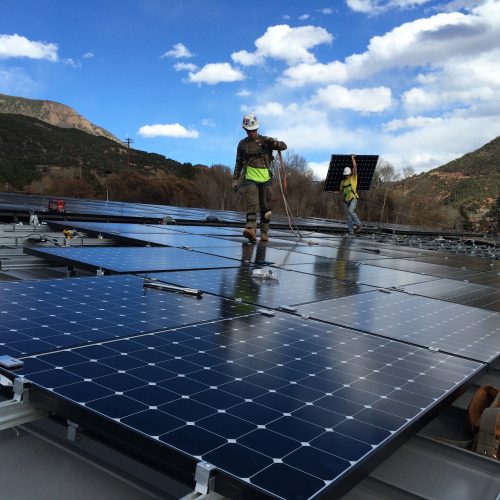Photo by Tim Griffith, courtesy of ZGF Architects

Renewable Energy
Thanks to the Innovation Center’s energy efficient design and low annual energy demands, RMI can produce enough energy through the solar panels on our rooftop to power the entire building plus six electric vehicles.
The Innovation Center is a true example of a grid asset. Thanks to high levels of efficiency and on-site energy production and storage, we’re able to not only generate all the energy we use over the course of a year but we can also control our load profile throughout the course of the day. This helps utilities avoid firing up dirty peak power plants when energy demand on the grid is greatest.
Thanks to a dynamic interface between our rooftop solar photovoltaic panels, on-site battery storage, and electric vehicles (which are fitted with conduit to allow for future bidirectional charging once it becomes available), we’re able to shed our building loads during peak times, and send clean electricity back to the grid when it is most needed.
On-Site Production and Storage

Solar Photovoltaics
An 83 kw solar-electric system is mounted on the Innovation Center’s roof and generates approximately 114,000 kWh each year. The system is made up of SunPower X21-335 watt solar-electric modules, which are among the most efficient on the market, delivering a maximum efficiency of 21.5%, 44% more power than conventional panels with a 25-year performance guarantee.

Battery Storage
A 30 kW 45 kWh battery storage system reduces the building’s peak energy demand, which will help us stay below a peak demand of 50 kw, which keeps us in the small-commercial rate class. RMI chose this lithium-ion storage system with a customizable controls system provided by Geli because it offered a level of power density and flexibility that enhanced the building’s capabilities to act as a living lab and teaching tool.

Innovation is the heart of what we do every day at SunPower, to ensure we continue making the highest-efficiency and most reliable solar solutions for our customers—so powering Rocky Mountain Institute’s Innovation Center with our solar technology was a natural fit. Not only are SunPower solar panels designed to last for 40 years or more, they’re built to withstand harsh environmental conditions including extreme cold, rain, and snow, making them ideal for the Colorado climate.
‐Howard Wenger, SunPower president, business units
Financing Solar Photovoltaics: A Model for Nonprofits
A common barrier to purchasing on-site solar photovoltaic (PV) capacity is the up-front capital cost—especially to nonprofit organizations who can’t take advantage of the tax incentives that make solar particularly attractive to homeowners or other commercial building owners.
That’s why we used a unique power purchase agreement (PPA) utilizing a pass-through contract with our utility. A PPA is an industry standard contract and ownership structure in which a third party owns and maintains the PV system, the building owner agrees to put the solar on their rooftop, and then the building owner agrees to buy all of the energy that the PV system produces.
While PPAs are quite common in the industry, they are rarely done for smaller systems (<500kw in size) suitable for small commercial buildings, and even more uncommon for nonprofit organizations.
The Innovation Center’s PV system is owned by a third-party entity (CollectiveSun) and financed by an investor who is blurring the lines between financial return and philanthropic support. In this case, the nonprofit organization (RMI) pays for the energy the system produces, which is passed through the utility to CollectiveSun, which in turn passes the earnings to the system’s investor at a lower return than a traditional PPA. This model is attractive to certain donors because they do receive a small return, while also helping provide a lower cost of renewable energy for the nonprofit (over a traditional PPA), which makes them an integral part of the organization’s net-zero energy strategy.
This financing model was made possible through cooperation and coordination with CollectiveSun, Sol Energy, PAE, SunPower, Black Bear Energy, and Holy Cross Electric, RMI’s local utility provider.

A solar financing solution that strengthens our relationships with donors, helps achieve our net-zero strategy, and provides a direct return on investment is an innovative solution that didn’t exist in the market. We worked with a number of different parties to make sure that we developed something really fleshed out and to a level that can be scalable across the country, to other nonprofit organizations and small businesses.
‐Craig Schiller, Rocky Mountain Institute
